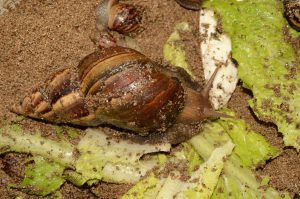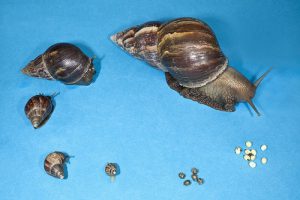Efforts Continue to Rid South Florida of Giant African Land Snails
Giant African Land Snail Eradicated from South Florida
FDACS declares Giant African Land Snail Eradicated from South Florida
We have exciting news in the world of invasive species in Florida! As of Oct 2021, Giant African Land Snail (GALS) has been declared eradicated from Broward and Miami-Dade Counties. Over the last decade, the Florida Department of Agriculture and Consumer Services (FDACS) and the United States Department of Agriculture and Consumer Services (USDA) have been hard at work to get rid of this pest in Florida.
What is eradication?
An invasive species is any organism that is non-native and causing damage in its new environment. This could be an animal, a plant, or any other organism. Eradication is the complete remove of a species from an area. This is one way of managing invasive species and other pest problems. One key to a successful eradication program is early detection of the pest. Eradication can be very costly, but the impacts of invasive species can be even higher. In the case of GALS, this invasive species can cause LOTS of problems (see section on "What is Giant African Land Snail?" for more info). So, it is worth all the eradication efforts.
Non-native pests can often spread very quickly. The longer a pest is in a new area, the harder it is to eradicate it. Therefore, it is very important to prevent the introduction of pests to new areas in the first place. Invasive species can be introduced to new areas through many pathways. In some cases, invasive species are accidentally introduced. For example, they might be a hitchhiker on goods, people or animals. Other times, they might be introduced intentionally. For example, they might appear valuable in the ornamental plant industry, pet trade, or agricultural world. Don't forget, this value does not outweigh the damage!
What is Giant African Land Snail?

Giant African Land Snail (GALS), Lissachatina (Achatina) fulica, is an invasive species. It is thought to originally be from East Africa. However, this pest has spread to many new places around the world including South American and areas of the Caribbean. It is a federally regulated pest. In 2011, GALS was found in South Florida in Miami. Soon after, eradication efforts began to rid the state of this terrible pest! This snail is very large (up to about 8 inches by 5 inches), one of the largest in the world. The shell is brownish with stripes and has 7-9 whorls.

In addition to being one of the largest, GALS is one of the most damaging snails in the world. GALS can reproduce very quickly! A single snail can produce up to thousands of eggs. It is a pest of many plants, both agricultural and ornamental, on farms, gardens and landscapes. GALS can also be a health hazard as they can transmit a parasite called rat lungworm to humans. GALS also outcompetes, and even eats, native snails. This can affect biodiversity and the local ecosystem. Their large shells can be a danger and sharp when broken. In addition, they can be a big nuisance such as when they eat stucco paint off buildings which contains calcium needed for their shells. People sometimes illegally sell these snails as pets. This is one way that GALS moves to new areas.
How did they eradicate GALS?
GALS was detected in South Florida in 2011 in Miami. This is actually the second time this pest was eradicated from Florida. In the 1960's, it took 10 years and nearly $1 million to eradicate it. Shortly after the 2011 detection, an emergency eradication program began to remove this pest from Florida. The recent program consisted of many inspections, pest surveys, treatment efforts, and public outreach. This included the collaborative efforts of many organizations including government, municipalities, landscaping companies, homeowner associates and many other groups.
Whenever a live snail was found, officials set up a half-mile radius, called a core, around the area. Authorities located these live snails thanks to the help of collaborators and the public. They used news, billboards, social media, and other advertisements to alert everyone of the snail problem. They even opened a snail detection phone hotline for people to call when they saw one. Detector dogs helped sniff out snails in the core areas. They removed the snails and had other treatment methods to kill snails too. The last live snail was found in 2017, but they continued to search to be sure they got them all. Over a decade and 160,000 snails removed, FDACS declared GALS eradicated from South Florida as of October 2021.
How can you stop the spread of invasive species?
- Don't be a part of the spread! Avoid moving plant materials (including firewood) across state or country lines. Do not travel with fresh produce. Check your vehicle, bag and clothes for hitchhikers when traveling. Clean your hiking/fishing gear, shoes, or other equipment when traveling. Select landscape plants that are native or non-invasive. Remove known invasive species (ie. plants, animals, etc.) from the landscape or other area. Buy plants from trusted sources. Don't release pets or plants into the wild.
- Be a detective and keep an eye out! You are another set of eyes looking for invasive species. If something seems unusual, it could be a new pest in our area. We highly encourage people to still be on the lookout for GALS. This pest could be reintroduced in the future.
- Submit suspicious samples! If you see a suspicious snail, you can report it to the FDACS-DPI hotline at 1-888-397-1517. You can also start the conversation about invasive species with your local count extension office. Find your local office here: https://sfyl.ifas.ufl.edu/find-your-local-office/. Your local extension office can answer your questions and point you to the right place to submit samples.
- Stay connected! Be sure to check the news for invasive species issues in your local area. You can also attend invasive species trainings or volunteer round up events. There are lots of trainings and events on invasive species across the state. Online, there are tons of social media groups dedicated to stopping the spread of invasive species.
Additional Resources
- UF/IFAS EDIS Giant African Land Snail in Florida
- FDACS Giant African Land Snail Page
- USDA Giant African Land Snail Resources
- UF Invasive Species Resources
- UF/IFAS Extension Seminole County Facebook Page
- Central Florida CISMA Facebook Page
- Don't Pack a Pest Program
- Florida First Detector Trainings

Posted: October 12, 2021
Category: Agriculture, Crops, Farm Management, Horticulture, Invasive Species, Pests & Disease, Pests & Disease, Turf, UF/IFAS, UF/IFAS Extension
Tags: Eradication, Giant African Land Snail, Invasive Species, News, South Florida
Source: https://blogs.ifas.ufl.edu/seminoleco/2021/10/12/giant-african-land-snail-eradicated-from-south-florida/
